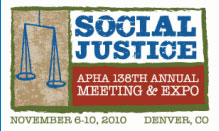In this Section |

220055 Lifestyle Behavior Change after Repeated HRA Participation: A Structural Equation Modeling ApproachMonday, November 8, 2010
Preliminary results of the test of a hypothesized model which utilizes constructs from the health belief and transtheoretical models to predict lifestyle behavior change in worksite wellness programs will be reported. The hypothesized model contains three latent concepts: perceived threat, decisional balance and self-efficacy. Exogenous variable information was obtained through secondary data analysis of health risk appraisal data from a large national corporation which provides health risk appraisal technology and worksite wellness programming. Participants in this study are representative of various industries across the United States and must have completed three consecutive HRAs in a four year span for inclusion in the data analysis. The impact of repeat HRA participation with risk feedback will be assessed via its effect on the construct of perceived threat. Other exogenous variables included in the model include: age, gender, ethnicity, job classification, job and life satisfaction, stress, current stage of change related to various lifestyle behaviors, health and family history, and overall health rating. Descriptive statistics will also be discussed.
Learning Areas:
Conduct evaluation related to programs, research, and other areas of practiceImplementation of health education strategies, interventions and programs Occupational health and safety Learning Objectives:
Presenting author's disclosure statement:
Qualified on the content I am responsible for because: I am currently a PhD candidate in the field of Health Promotion and have worked with/consulted for worksite wellness programs in my region for several years. I agree to comply with the American Public Health Association Conflict of Interest and Commercial Support Guidelines, and to disclose to the participants any off-label or experimental uses of a commercial product or service discussed in my presentation.
Back to: 3177.0: Occupational health and safety posters IV
|

 Click to
Click to